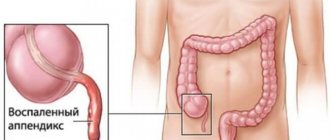The question under what anesthesia to remove appendicitis is very common among patients, because some prefer to go into a medicated sleep so as not to see or hear anything, while others, on the contrary, want to remain conscious during the operation. Indeed, you can cut out the appendix in two ways: under general and local anesthesia. But the patient is unlikely to be given a choice: first of all, the doctor will rely on medical indications.
Local anesthesia
Before the advent of general anesthesia, appendicitis was operated on this way: by injecting the surgical area with local anesthetics. The patient did not sleep and heard the doctors operating instruments and talking to each other.
Today this method is used extremely rarely because anesthetics must be constantly added due to their short-term effect. And if you miss the moment, the patient will begin to feel pain. It is because of these risks that such anesthesia is used only in the presence of absolute contraindications to epidural and general anesthesia (or in the absence of the possibility of performing them - for example, emergency surgery in the field).
Algorithm
It is advisable for the patient to undergo sedation before surgery. This is an intravenous (in rare cases, oral) administration of sedatives that do not put a person to sleep completely, but calm him down, putting him in a state of half-asleep, so that the person does not panic and does not complicate the work of doctors.
The sequence of local anesthesia is simple: first, an anesthetic is injected into the lower right part of the abdomen, then the operation begins. And every 20 minutes additional anesthetic injections are given. At the end of the operation, sensitivity returns quite quickly, as does the pain from the suture. Therefore, the patient is prescribed analgesics.
By the way! Appendicitis is removed under local anesthesia only by adults, because the child may move and scream out of excitement and fear. This is dangerous for his nervous system and also inconvenient for the medical team.
Drugs
Among the drugs for local anesthesia when removing appendicitis, novocaine and its analogues are used: lidocaine, dicaine, bupivacaine. The remedy is selected depending on the patient's medical history. For pregnant women, for example, bupivacaine is contraindicated due to its adrenaline content and the high risk of increased uterine tone.
Appendectomy under local anesthesia has its advantages and disadvantages.
| pros | Minuses |
| No complex equipment needed (only syringes and ampoules with novocaine) | There is a risk of feeling pain |
| Safe for the human body | The patient may feel afraid |
| The patient quickly recovers from local anesthesia | In case of force majeure, it is necessary to urgently perform general anesthesia |
Types of anesthesia
Anesthesia is divided into two types:
- Local. This involves the administration of painkillers directly next to the site of the future incision. Rarely used.
- General. Putting the patient into a deep sleep.
Appendicitis is removed under general anesthesia by administering a drug containing a large number of components. The medication helps induce sleep. The subsequent exit from it occurs gently, sensitivity is quickly restored.
Local
Another name for this procedure is regional. Today it is practically not used. But it was popular 30 years ago.
An experienced anesthesiologist injects novocaine into the peritoneal area. This is done under pressure and covers all skin layers. As a result, the sensitivity of the nerve endings is blocked. Throughout the operation, the anesthesiologist continues to administer the solution, since the effect of the drug is short-lived.
Advantages
Positive aspects when using local anesthesia:
- The method is simple and does not require serious equipment. Suitable for field use.
- Safe. This method of anesthesia is not considered dangerous since there is no effect on the central nervous system. The patient is conscious.
- The effect of anesthesia wears off quickly. Several hours pass and the numbness goes away.
Flaws
Negative points of the local method:
- It is not advisable for young children to undergo surgery under local anesthesia. An adult should lie still, but a child may not be able to be held.
- Peritonitis. The occurrence of complications requires more time for surgery. Novocaine acts for no more than 40 minutes.
- The appendix is excised using laparoscopy.
People undergoing surgery under local anesthesia often complain that they feel pain. Today, anesthesia of a specific area of the body is performed only if general anesthesia is contraindicated.
Methods
Several methods are used to administer anesthetic to adults:
- Spinal. The injection is given in the lumbar region. This helps block nerve impulses at the roots located in the spinal cord.
- Epidural. The anesthetic is injected through the back. The catheter is placed between two vertebral discs. The drug mixes with the cerebrospinal fluid, as a result, the nerves lose sensitivity.
- Conductor. The area requiring anesthesia is injected. The introduction of novocaine occurs slowly, promoting a gradual loss of sensitivity. In this case, the nerve and surrounding tissues are not damaged.
For pregnant women, only local anesthesia is used when removing the affected appendix. In this case, it is necessary to save the life of not only the mother, but also the developing fetus. The cutting is done using laparotomy or laparoscopy.
General
The most popular method used during surgery.
Advantages
Positive points:
- The patient falls into a deep medical sleep. Afterwards the person has no memories of the process.
- There is no pain during surgery. Induction of sleep helps to switch off all nerve receptors.
- The anesthesiologist regulates the patient's sleep time. As a rule, the surgeon cannot tell in advance the duration of the surgical procedure. It is possible that additional complications are discovered during surgery that affect the duration of the procedure. This may be the development of peritonitis, excessive bleeding, or incorrect location of the appendix.
- The anesthesiologist can accurately determine when the patient will wake up.
- Today, the pharmaceutical industry offers a wide selection of anesthetics. The choice of medications is up to the doctor. First, the patient is tested to determine the perception of the chosen remedy (allergy test).
Stages
The introduction of anesthesia is carried out gradually in several stages:
- Premedication. This is the gradual introduction of an anesthetic so that the cardiovascular system does not cause complications, as well as to maintain the general condition of the body. There is a gradual addiction to the substance.
- Induction anesthesia. The patient slowly falls asleep. A tube is inserted into the trachea to facilitate breathing and prevent saliva and juices from entering the lungs. The person is connected to artificial ventilation. Then drugs are administered to relax the muscles responsible for breathing.
- Maintaining a state of sleep. The anesthesiologist is next to the patient during the operation, monitoring breathing and pulse. If necessary, it can prolong the effect of anesthetics.
- Removal from sleep state. When the operation is over, the anesthesiologist’s task is to bring the patient out of anesthesia and return him to natural breathing.
Modern anesthetic drugs can provide a smooth introduction to anesthesia and an equally gentle removal from it.
Methods
They differ according to the method of entry into the human body:
- Intravenous;
- Masks.
The quality of anesthesia does not depend on the method of entry into the body. For someone on the operating table, the main thing is not to feel pain during the procedure. When choosing medications, the doctor relies on the patient’s condition, the duration of the surgical intervention, and the patient’s characteristics.
Drugs
Medicines administered through a vein: Viadryl, Ketamine, Propofol, Diprivan, Sodium thiopental, Sodium hydroxybutyrate.
Products related to mask preparations: Sevoflurane, Halothane, Isoflurane, Desflurane, Nitrous oxide, Ftorotan.
The combined use of anesthetics is possible.
Regional anesthesia
Another option for local anesthesia for appendectomy is epidural regional anesthesia. The anesthetic is injected directly into the spinal nerves, which “turn off” sensation in the entire lower body: legs, groin and lower abdomen. The patient remains conscious.
Algorithm
To reduce the patient's anxiety during appendectomy under epidural anesthesia, sedation is also done. Only after this the necessary actions for regional anesthesia are carried out.
- The patient takes a position lying on his side, tucking his knees towards himself, or sitting, bending his body forward.
- The doctor finds a point between the 3rd and 4th vertebrae, treats this part of the back with antiseptics and applies superficial anesthesia with a thin syringe.
- After a couple of minutes, the anesthesiologist gives a second injection, which will desensitize the entire lower part of the body. The needle must reach the dura spinal membrane through the intervertebral ligaments.
- Approximately 3 ml of anesthetic is injected (plus or minus, depending on the patient’s weight).
- The injection site is sealed with an antiseptic plaster.
- The patient lies on his back and waits for the local epidural anesthesia to take effect: first, warmth spreads through the legs, then they become cottony, and finally, sensitivity completely disappears.
Doctors fence off the surgical area with a special curtain so that the patient does not see the blood, and begin to remove appendicitis. The operation takes about an hour, and anesthesia lasts from 1.5 to 4 hours.
Drugs
Specially purified solutions of local anesthetics are used: lidocaine, bupivacaine and ropivacaine. To enhance their effect, morphine, fentanyl and other opiates are sometimes added (if, in addition to appendicitis, there is a threat of peritonitis). Due to opioids, the patient may experience dizziness and nausea after coming out of the epidural.
Some advantages of epidural anesthesia are the same as regular local anesthesia: relative safety, absence of side effects after recovery from anesthesia. Another advantage is that the patient will definitely not feel anything, because this is a very reliable pain relief. Of the minuses: the risks of “missing” and puncturing a nerve in the back (if the anesthesiologist is experienced, this will not happen) and difficulties with urination on the first day after the operation (sometimes you have to insert a urethral catheter, and this is not very pleasant).
General anesthesia
Priority method for appendicitis surgery. Combined anesthesia with preliminary premedication is mainly used. The patient slowly and gradually falls into a medicated sleep, and wakes up with his appendix removed. During the operation, he does not see, hear or feel anything.
Algorithm
Combined general anesthesia for appendicitis involves the use of both intravenous and inhalational anesthetics. First, sedatives are injected into the vein, which “puts the patient to sleep.” Because At the same time, they also depress breathing; an oxygen mask is put on the person. Then the mask is temporarily removed to install a special tube in the trachea through which an anesthetic will be administered to maintain a state of narcotic sleep throughout the surgical procedure. Muscle relaxants are also given through a vein to help prevent muscle spasms.
Drugs
For general anesthesia when removing appendicitis, many different anesthetics are used: liquid and gas. In a certain concentration, they give the desired effect: they put the patient to sleep (deprived of consciousness), anesthetize and relax the muscles. According to the method of administration during appendectomy, the following drugs are used:
| Intravenous anesthetics | Inhalational anesthetics | Muscle relaxants (intravenous) |
| Viadryl | Sevoflurane | Mydocalm |
| Ketamine | Halothane | Sirdalud |
| Deprivan | Nitrous oxide | Baklosan |
| Sodium hydroxybutyrate | Ftorotan | |
| Propofol | Isoflurane |
Contraindications
General anesthesia has the most contraindications. Because of them, alternative methods for removing appendicitis (under local and regional anesthesia) have emerged. Thus, general anesthesia is contraindicated for:
- acute cardiac, as well as liver and kidney failure;
- bronchial asthma and pneumonia;
- pregnancy;
- the patient is intoxicated by alcohol or drugs (in case of peritonitis, surgery cannot be postponed, so local anesthesia is given).
The advantages of general anesthesia when removing appendicitis are obvious. The person is unconscious and experiences neither excitement nor fear. And he doesn’t remember anything. The disadvantages of the method are associated with the withdrawal from narcotic sleep: the patient experiences dizziness, nausea, and absent-mindedness. It is also believed that general anesthesia “takes away” about 2 years of a person’s life.
Under what anesthesia is appendicitis removed?
It is generally accepted to divide pain relief for this operation into two categories:
- General anesthesia for appendicitis;
- Local anesthesia (local anesthesia).
In addition, an important point in both cases is tracheal intubation (endrotracheal technique). What it is? During the process of resection (removal of the appendix), there is a high risk of gastric masses entering the respiratory tract; if the patient consumed food or any liquid before the operation, this procedure implies their protection (a breathing tube is inserted into the trachea). Despite the fact that it is not recommended to remove appendicitis without anesthesia and this procedure, surgeons often neglect the second step. Often intravenous anesthesia is used for appendicitis, which eliminates this stage.
General anesthesia
It is quite rare to remove appendicitis under local anesthesia. General anesthesia is the best option not only for the patient, but also for the doctor, who will not be interfered with in his work. Its advantages:
- Complete absence of any pain. After falling into sleep, a person's sensitivity turns off;
- Lack of memories. This is not the most pleasant procedure that you would like to leave a mark on in your memory;
- The ability to control and, if necessary, increase the time that the patient will be asleep. This is necessary if complications arise during the operation, the list of which includes: Bleeding;
- Peritonitis (inflammation);
- Non-standard location of the appendix;
General anesthesia for appendicitis cannot be called ordinary anesthesia, in which the patient is simply injected with the selected drug and falls asleep. It has several stages:
- Premedication. Preparation for the main stage. Most often it includes the use of narcotic analgesics, sedatives and antihistamines;
- Induction anesthesia. The patient gradually begins to be immersed in a state of sleep. At this stage, tracheal intubation is performed and the patient is transferred to artificial ventilation. Next, muscle relaxants are administered, thanks to which the muscles relax (now intubation helps a person breathe);
- If necessary, the surgeon may prolong euthanasia if the condition of the heart and lungs allows it;
- Removal from sleep. The transition to spontaneous breathing occurs only after waking up.
There are many drugs used, but the following are often used:
- Ketamine;
- Propofol;
- Viadryl;
- Halothane;
- Ftorotan;
- Nitrous oxide;
- Isoflurane;
- Sevoflurane et al.
This procedure has several contraindications:
- Impaired functioning of the heart and cardiovascular system;
- Kidney and liver failure;
- Bronchial asthma;
- Pregnancy and lactation period.
Local anesthesia
Many people believe that it is better to remove appendix under local anesthesia. This is explained by its some advantages over the general one, but few people think about its disadvantages. Its advantages include:
- Patient safety. In this case, the patient is in almost no danger;
- Simplicity of the procedure. There is no need for special equipment and several steps. Such anesthesia can be used even in field or emergency conditions;
- Fast recovery. The numbness goes away after a couple of hours.
The disadvantages include:
- First of all, this method can only be used on adults. It will not seem realistic to calm a child of even middle age in this situation;
- If you have undergone such anesthesia, then the removal of appendicitis will only take 30-40 minutes for the entire operation. If it does not go smoothly, it may affect your health;
- Sometimes the analgesic effect is insufficient. Some people feel everything and this is the main reason why this method is avoided and they resort to its use only in cases where it is impossible to perform general anesthesia;
- During the process, the person is conscious;
- If there is increased excitability of the nervous system, local anesthesia should also not be used.
Remember, appendicitis cannot be removed without anesthesia at all, as this is fraught with the development of painful shock.
Possible complications
No matter how simple an appendectomy is, complications still occur during it. And they can be connected precisely with anesthesia. An allergy to an anesthetic is a common cause of sudden reactions (from edema to anaphylactic shock), which must be stopped immediately. The same can happen if the drugs turn out to be expired or of poor quality, which in practice is considered an exceptional case.
Complications with local and regional anesthesia are most often associated with touching a nerve or vessel when inserting a syringe. After surgery, there may be a hematoma or even tissue necrosis in this place if the doctor has not corrected the consequences of the error.
The doctor determines what anesthesia will be used to remove appendicitis. Initially, general is usually chosen, but if contraindications are identified, one has to opt for alternative local anesthesia.









